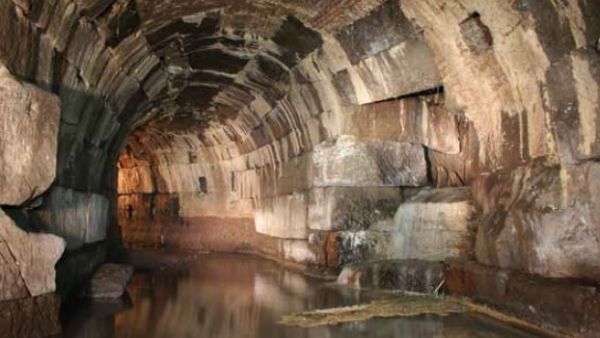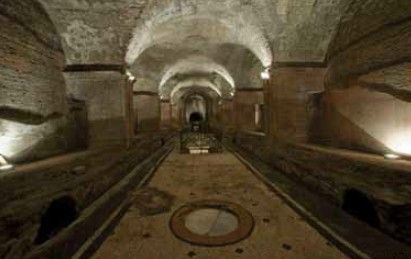One way to understand the modern city is to discover what lies underground.
There is a myriad of underground sites in central and suburban Rome that reveal the true physical and historical depth that defines the city.
Within the past year, two new sites have opened new perspectives on the architectonic layering of the city.
The imposing ruins of the Baths of Caracalla, long a testimony to Roman engineering, social life, water efficiency and hygiene have a new underground feature which was open for guided visits until 30 September 2013.
Completed in late 2012, it consists of two kilometres of service chambers and galleries that made up the hydraulic plant and intricate heating system. The space was used for wood deposits, a water mill, ovens and stoves, furnaces and cauldrons. The underground portion of the baths not only offers a glimpse of behind-the-scenes life and labour of the spa complex, but also provides evidence of its splendour. The tunnel space, designed to be large enough to accommodate wagons, has been transformed into an antiquarium, displaying pieces of ornate decoration from nearly 2,000 years ago. Cornice fragments, figured capitals and historic reliefs from the bath’s gymnasium, library and frigidarium (cold bath) hall are placed in the bare brick setting of the ancient hydraulic system and storage centre.
Also visible under the bath complex, albeit on rare occasions, is a well-preserved mithraeum, or temple dedicated to the practice of Mithraism, a popular ancient Roman cult originating in Persia.
The entire bath complex was built by Emperor Caracalla between 212 and 216 AD and it is thought that more than 9,000 labourers worked on the site during its construction. The underground network reveals how much labour went in to keeping the baths running and serving more than 6,000 bathers at once.
Another site uncovering the mysteries of Roman religion and daily life are new excavations at the church of S. Maria in Cosmedin, opened to the public at the end of 2012. Visitors can now descend below the main altar of the church to find several layers of physical and religious history.
The church was built in the eighth century with a crypt made by digging out the podium of a second century BC temple to Ceres. The small chamber below the main altar contains blocks of tufo from the ancient altar of Hercules, known as the Ara Maxima, and eight niches that stored relics of Christian martyrs from the mediaeval crypt.
A representative from the church, Valentin Tomescu, who has promoted underground tourism for over a decade, plans to put the funds donated by visitors to opening more areas under the church. He believes this site is especially important because of its location in the ancient city’s commercial centre along the river banks near the main cattle market or forum boarium. It is also thought to be near where the shepherd Faustulus found the twin founders of Rome, Romulus and Remus.
The church is however most famous for the Bocca della Verità in the portico. The sculpture is believed to have been a drain cover representing the face of the god Oceanus. According to a popular legend, made famous by the 1953 romantic comedy Roman Holiday, anyone putting a hand into its mouth would have it bitten off if they were not telling the truth.
Other churches with multiple layers underground include the Basilica of S. Clemente and the church of S. Nicolo in Carcere. Like the Baths of Caracalla, S. Clemente offers a glimpse of Mithraism with one of the best preserved mithraea discovered in the Roman empire. The site also descends to an early Christian church just below the mediaeval church at street level, and then further down to ruins of an ancient Roman building believed to be a domestic dwelling.
Similar to S. Maria in Cosmedin, the church of S. Nicolo in Carcere is located in the commercial centre of ancient Rome on top of the ancient forum holitorium or vegetable market.
The church was built in the 11th century with parts of three different ancient temples occupying its façade. Temple remnants, foundations for shops and offices, and a small pile of bones can be found underneath. Guided tours are organised by Associazione Culturale Amici di Roma on 21 December and 4 January.
There are two associations in Rome that offer a variety tours of underground sites. Sotteranei di Roma and Roma Sotteranea collaborate with the capital’s archaeological authorities to provide a comprehensive list of guided tours and introductory courses to discover the complex underground systems of engineering, religion, life and burial that define 3,000 years of Roman history and architecture. Associazione Culturale Amici di Roma also organises guided tours. www.amicidiroma.it.
Side notes
Some of these sites are underground because the level of today’s city is higher than the ancient one. Others, such as the mithraea for the secret pre-Christian worship of Mithras and the tunnels for the aqueducts, were built underground. Most of these sites are not open to the public on a regular basis, either because they are too dangerous or because it is impossible to provide staff for visits. See www.sotterraneidiroma. it, www.romasotterranea.it and www.amicidiroma.it for possible visits or www.comune.roma.it or www. beniculturali.it for more information.
▶ Aqueducts. Many of the tunnels that carried water to ancient Rome are still being excavated and are only open for special guided visits. On 15 December there is a tour organised by the Associazione Culturale Amici di Roma of the Castellum Aquae under the old cinema Trevi and parts of the Acquedotto Vergine. www.amicidiroma.it.
▶ Auditorium (or nymphaeum) of Mecenate. In Largo Leopardi in the Esquilino, it is only open for special visits and sometimes hosts cultural events organised by the Comune di Roma.
▶ Cloaca Maxima. Rome’s main drainage system, originally built by the Etruscans as an open-air system and then covered over by the Romans. The exit can still be seen near Ponte Rotto and Ponte Palatino.
▶ Christian catacombs. Most of these are along Via Appia and some have recently been restored such as S. Priscilla on Via Salaria. They are open to the public and are easy to visit.
▶ Church of S. Crisogono. Underground site includes an early Christian church and a third-century Roman house. On 22 December there is a guid- ed visit organised by Amici di Roma, www.amicidiroma.it.
▶ Church of S. Lorenzo in Lucina. The underground site in Piazza in Lucina was originally thought to have been just a Roman house for early Christian worship but recent research indicates that it might have been a pre-Christian temple to Giunone Lucina, the goddess of pregnant women.
▶ Domus Aurea. A large villa built by Nero after the fire of Rome in about 64 AD. It is closed for restoration. To follow the extent and progress of the restoration see archeoroma.beniculturali.t/cantieredomusaurea/
▶ Jewish catacombs in Villa Torlonia. There are several Jewish catacombs in and around Rome but the ones in Villa Torlonia are the largest and most famous.
▶ Mithraeum in Circo Massimo. Guided visits only. This five-room mithraeum, at the Bocca della Verità end of Circo Massimo, was first discovered in 1931.
▶ Mithraeum in S. Prisca on the Aventine, Via di S. Prisca 11. The church of S. Prisca was built over a temple to Mithras. It could be open on the second and fourth Sundays of the month in the afternoons but it is best to check with the church.
▶ Palazzo Valentini in Piazza Venezia. The remains of Roman houses found below Palazzo Valentini just off Piazza Venezia. 09.30-17.30, closed Tues and public holidays, www.palazzovalentini. it.
▶ Vatican necropolis dating to Imperial times. Only private visits on request to scavi@fsp.va, www.vatican.va or directly to the excavations office to the left of the Bernini colonnade in St Peter’s Square.
Theresa Potenza
























